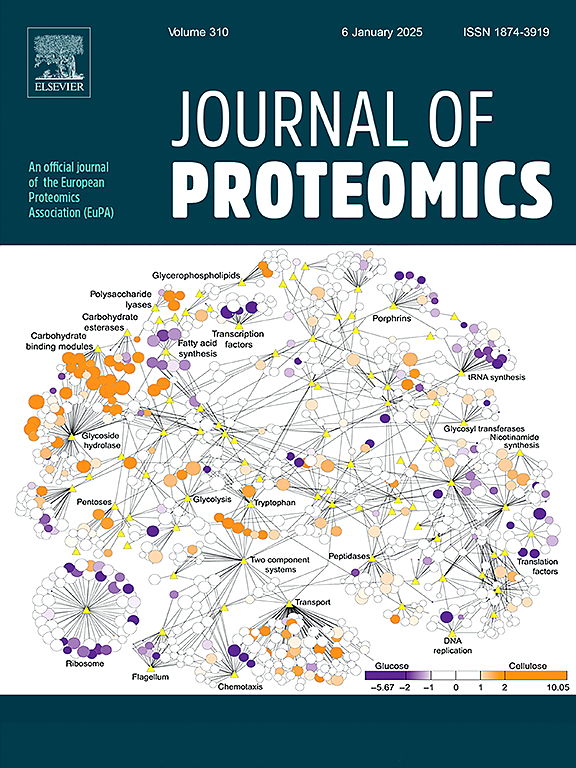利用蛋白质组学和磷酸化蛋白质组学分析鉴定多年生转基因杨树卷曲叶表型的关键基因。
IF 2.8
2区 生物学
Q2 BIOCHEMICAL RESEARCH METHODS
引用次数: 0
摘要
毛白杨741是中国北方的优良树种。由于其生长迅速,生产力高,遗传工具广泛,一直是林业研究的重点。多年生转基因杨杨741表现出持续过表达的pcycd3;3,一致表现出近轴弯曲和明显的表面起皱。叶片的曲率对林业生产系统具有重要意义。适度卷曲叶片可以优化光接收角度,从而提高光吸收效率和光合性能,缩短木材成熟周期,提高经济可行性。蛋白磷酸化修饰是细胞周期过程中的主要调控机制。为了研究这些形态学变化,我们对转基因和野生型植物的叶片进行了TMT定量蛋白质组学和磷酸化蛋白质组学研究。在鉴定的6005个蛋白中,648个蛋白丰度增加,386个蛋白丰度降低。在磷酸化蛋白质组学中,68个蛋白表现出不同程度的磷酸化,其中31个蛋白磷酸化增加,37个蛋白磷酸化减少。定量蛋白质组学发现了与光合作用、植物激素和细胞增殖相关的蛋白质丰度的显著变化。值得注意的是,组蛋白去乙酰化酶6 (HDA6)、ANGUSTIFOLIA (AN)和纤维素合酶样(CSL)蛋白在转基因杨树中显著上调。磷酸化蛋白质组学显示HERK1、DGK、OST1和BIG等蛋白富集,这些蛋白参与油菜素内酯(BR)、脱落酸(ABA)和其他植物激素信号通路。这些分析证明了外源基因ptocycd33.3整合对多年生杨树741光合途径、激素信号传导和细胞增殖的影响,突出了其在调节叶片形态发生中的作用。意义:目前对外源引入基因对杨树物种影响的评估主要局限于每年或半年一次的转基因标本的短期研究。在本研究中,我们收集了741棵多年生野生型和转基因杨树的成熟叶片,并进行了全面的蛋白质组学和磷酸化蛋白质组学分析。研究结果不仅揭示了与卷曲相关的多种蛋白丰度的变化,还揭示了叶片形态发生的关键植物激素和信号通路。这些发现补充了参与叶片形态发生的信号网络,为多年生转基因植物的研究提供了新的视角。本文章由计算机程序翻译,如有差异,请以英文原文为准。

Identification of crucial genes sustaining the curled leaf phenotype in perennial transgenic poplar via advanced proteomic and phosphoproteomic analyses
Populus tomentosa hybrid poplar 741 is a superior tree species in northern China. Due to its rapid growth, high productivity, and range of available genetic tools, it has always been a focus of forestry research. The perennial genetically modified Populus 741, exhibiting sustained overexpression of PtoCYCD3;3, consistently shows adaxial curvature and pronounced surface wrinkling. The curvature of leaves holds great significance for forestry production systems. Moderate leaf curling can optimize the angle of light reception, thereby enhancing the efficiency of light absorption and photosynthetic performance, shortening the wood maturation cycle, and improving economic feasibility. Protein phosphorylation modification is a major regulatory mechanism in the cell cycle process. To investigate these morphological changes, TMT quantitative proteomics and phosphoproteomics were performed on leaves of transgenic and wild-type plants. Among 6005 identified proteins, 648 showed increased abundance, whereas 386 were reduced. In phosphoproteomics, 68 proteins exhibited differential phosphorylation, with 31 increasing and 37 decreasing. Quantitative proteomics identified significant changes in protein abundance associated with photosynthesis, phytohormones, and cell proliferation. Notably, histone deacetylase 6 (HDA6), ANGUSTIFOLIA (AN), and cellulose synthase-like (CSL) proteins associated with leaf curling were significantly upregulated in transgenic poplar. Phosphoproteomics revealed enrichment of proteins such as HERK1, DGK, OST1, and BIG, which are involved in brassinosteroid (BR), abscisic acid (ABA), and other phytohormone signaling pathways. These analyses demonstrated the impact of exogenous gene PtoCYCD3;3 integration on photosynthetic pathways, hormone signaling, and cell proliferation, highlighting its role in modulating leaf morphogenesis in perennial Populus 741.
Significance
Current assessments of the effects of exogenously introduced genes in Populus species are largely limited to short-term studies in annual or semiannual genetically modified specimens. In this study, we collected mature leaves from both perennial wild-type and transgenic 741 poplar trees and conducted comprehensive proteomic and phosphoproteomic analyses. The results not only revealed alterations in the abundance of multiple proteins associated with leaf curling but also elucidated key plant hormones and signaling pathways involved in leaf morphogenesis. These findings complement the signaling network involved in leaf morphogenesis and provide a novel perspective for studying perennial transgenic plants.
求助全文
通过发布文献求助,成功后即可免费获取论文全文。
去求助
来源期刊

Journal of proteomics
生物-生化研究方法
CiteScore
7.10
自引率
3.00%
发文量
227
审稿时长
73 days
期刊介绍:
Journal of Proteomics is aimed at protein scientists and analytical chemists in the field of proteomics, biomarker discovery, protein analytics, plant proteomics, microbial and animal proteomics, human studies, tissue imaging by mass spectrometry, non-conventional and non-model organism proteomics, and protein bioinformatics. The journal welcomes papers in new and upcoming areas such as metabolomics, genomics, systems biology, toxicogenomics, pharmacoproteomics.
Journal of Proteomics unifies both fundamental scientists and clinicians, and includes translational research. Suggestions for reviews, webinars and thematic issues are welcome.
 求助内容:
求助内容: 应助结果提醒方式:
应助结果提醒方式:


